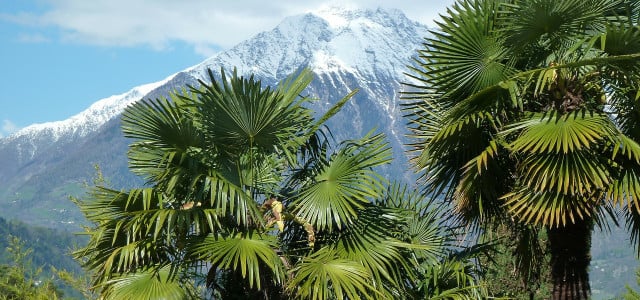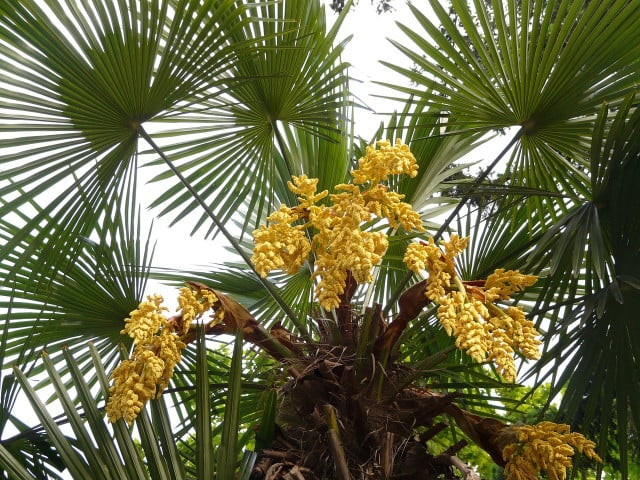
Hardy palms bring an exotic touch to the home garden and survive the cold months without any problems. We introduce you to the most important species.
Hardy tropical plants
Palm trees bring tropical flair to gardens and balconies. The exotic plants are naturally accustomed to warm temperatures. Nevertheless, there are some hardy palms that can survive even moderately cold winters in our latitudes if cared for properly.
Contents
Hardy palms: These varieties tolerate cold weather

Among the most famous hardy palms are:
- Needle palm
- Chinese hemp palm
- Wagner’s hemp palm
- Dwarf palm
- Needle palm
The needle palm is one of the most frost-resistant palms. If you live in a region where winters are particularly cold, you are on the safe side with this hardy palm. It can tolerate temperatures as low as -20 degrees. If it gets even colder, you should cover it with a winter protection to be on the safe side.
In general, the coniferous palm likes a full sun location. Since it grows very slowly and also forms only shallow roots, the hardy palm is well suited for small gardens (for example, cottage gardens) or the balcony. It reaches a maximum size of two to three meters.
Due to its shallow roots, the coniferous palm does not tolerate wind. Therefore, a wind-protected location is indispensable for it. If there is a lot of snow in winter, it is also possible that the small palm plant will topple over under the weight of the snow. In this case, regularly shake the palm fronds free.
Chinese hemp palm
In contrast to the coniferous palm, the Chinese hemp palm is a much faster growing hardy palm. The hemp palm is well suited for sufficiently large gardens or front yards. It can tolerate temperatures down to -18 degrees without special protection. After that you should protect root area and trunk. From -14 degrees, the leaves may die. However, this is not tragic, because the next summer quickly grow new ones.
Depending on location and weather, the hemp palm can grow up to 12 meters high. In Europe, however, it usually only reaches a size between six and eight meters. As a location, it prefers a sunny to semi-sunny place, which should also be protected from the wind.

Wagner’s hemp palm
Closely related to the Chinese hemp palm is Wagner’s hemp palm. It too can withstand temperatures between -12 and -18 degrees. Among hardy palms, Wagner’s hemp palm is best suited for windy locations. Thanks to its robust and stiff palm fronds, it withstands drafty places particularly well. Nevertheless, it should also be sufficiently sunny to half-sunny for this hardy palm.
Dwarf palm
The dwarf palm is one of the smallest hardy palms. It grows to a maximum of one to two meters tall and grows more in width than in height. Due to its small growth, the dwarf palm is also ideal for cultivation as a pot plant. It is therefore the best hardy palm for the balcony.
However, the dwarf palm is also the most sensitive to cold among the hardy palms. Therefore, planting it outdoors is recommended only in milder regions. It tolerates minus temperatures up to a maximum of – 13 degrees. Whether cultivated in a pot or outdoors, you should cover your dwarf palm with additional winter protection when the temperature drops below zero degrees. Dwarf palms in pots are best brought indoors below zero degrees to overwinter in a cool, bright place.
In general, the dwarf palm prefers full sun and warm locations. It copes well with wind due to its low growth.
Hardy palms – when to plant?
The best time to plant all hardy palms is between May and mid-June. This gives the palms plenty of time to root in their new location before the onset of winter. To maintain healthy and hardy plants, you should provide all palms with a sunny and warm location. All hardy species love south-facing spots that are protected from the wind.
Winter protection for palms

If the temperatures fall below the tolerable limit for the palms, you should provide them with winter protection. For this purpose, frost protection fleece and bark mulch are particularly suitable. When you apply frost protection, pay attention to the following points:
- Even with hardy palms, the root area is particularly sensitive to cold. To be on the safe side, you should therefore cover the ground cover of all free-standing palms with a generous layer of bark mulch in the fall. The layer should be a good 20 to 30 centimeters thick. If you like, you can also mix the bark mulch with some autumn leaves or brushwood.
- The warming layer of bark mulch also has the advantage of absorbing moisture from precipitation and keeping it away from the delicate roots.
- The leaf crown of hardy palms should also be given additional protection in cold winters. To do this, first tie all the palm fronds loosely together with sisal or coconut rope. Be careful not to knot too tightly so that the fronds do not bend. Then wrap the tied fronds with a light- and air-permeable winter fleece.
- The trunk of hardy palms usually does not need any further protection.

